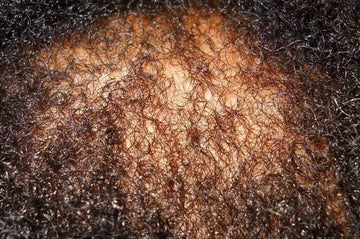
(Written by Dr Ophelia E. Dadzie)
Background
Central Centrifugal Cicatricial Alopecia (CCCA), also known as hot-comb alopecia, follicular degeneration syndrome or chemically induced cosmetic alopecia, is a form of scarring hair loss, of unknown cause that is commonly seen in women of African ancestry.
It has the following features:
- Central (crown) portion of the scalp is where the problem begins
- Centrifugal (circular) pattern is the outward pattern in which this problem progresses
- Cicatricial (scarring) of the hair follicles occurs
- Alopecia (hair loss) is progressive
With CCCA, the hair loss may appear suddenly and progress relentlessly. Although it predominantly occurs in women, cases in men and children have been reported.
The cause of CCCA is unknown. There may be a hereditary component to CCCA and a combination of hair care habits and practices may cause or contribute to the condition (such as wearing braids with extensions or weaves to style the hair (the chronic pulling or traction of the hair may produce inflammation and destruction of the follicles).
Once the hair follicles become damaged or destroyed, scar tissue forms and hair loss is permanent. Therefore, if you suspect that you may have CCCA, it is important to see a physician (preferably a dermatologist with expertise in hair and scalp disorders) sooner rather than later.
Making the diagnosis
This involves taking a detailed history from the patient, as well as examination of the scalp and the rest of the skin. Photographs may be taken of the scalp. This is to ensure that there is an objective method of documenting the hair loss and therefore having a baseline to compare following therapy. Dermatoscopy (handheld lens with light) is used to examine the scalp is usually undertaken.
It is likely that a scalp biopsy will also be undertaken- this is a procedure in which a small area of the scalp is removed after numbing medication is administered. A stitch is then placed to close the areas.
Once the diagnosis of CCCA is confirmed, the goal of any therapy offered will be to stop the progression of the disease, rather than to reverse the area of hair loss. If there are any associated symptoms or other hair and scalp disorders, these can also be addressed.
The diagnosis is confirmed...now what?
Since we still do not know the exact cause of CCCA, outlining a treatment is difficult and is based on anecdotal evidence, rather than on any published clinical trials.
The first step is to stop any styling practice that may be causing or contributing to the hair loss. Often that means no hot combs, no tightly applied rollers, braids or weaves, blow drying or relaxers for a period of time. Sometimes hair care practices can be resumed but with modifications (see below). Taking a break from harsh styling and substituting gentler techniques may allow the inflammation to resolve, the scalp to heal and hair growth to resume.
Medications may also be used. Oral and/or topical/intralesional medications may be used to reduce inflammation. Finally, once the inflammation is minimized, over-the-counter Minoxidil (Regaine) to stimulate grow of follicles that have not been destroyed may also be used.
Appropriate camouflage techniques (including the use of wigs) may also be discussed. In some settings hair transplantation may be used, although the severe scarring may make this procedure technically difficult.
Modifications to hair care regime
-
Seek professional/salon hair treatment (i.e. apply relaxers in a reputable salon, with a well-trained professional)
-
Basing of scalp prior to application of relaxer (minimizes irritation to the scalp)
-
Choose a milder relaxer or sensitive scalp formulation
-
Touch-up to the roots, no frequently than every 12 weeks
-
Take relaxer holidays
-
Consider chemical free hairstyles (natural hairstyles)
Tags:




